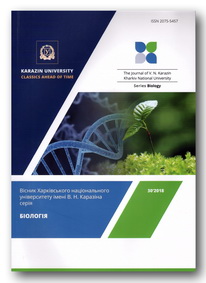Histomorphological changes in the rat pancreas after methionine administration
Abstract
The effectiveness of using various methionine preparations for activating pancreatic function is ambiguous; the reasons may include differences in dosage and duration of methionine administration. The question remains, in what extent the methionine application is efficacious for increasing functional activity of a healthy pancreas. The aim of our study was to investigate morphological changes in pancreas after prolonged administration of methionine. The experiments were carried out on 24 males of Wistar rats at the age of 15 months. During 21 days, the experimental animals received methionine at a daily dose of 250 mg/kg of body weight in addition to the standard diet. Histological preparations were made from pancreatic tissue according to standard method. Morphometry was performed using the computer program «Image J». The rats were taken out of the experiment under ether anesthesia. The studies were carried out in accordance with the provisions of the "European Convention for the Protection of Vertebrate Animals used for Experimental and Other Scientific Purposes" (Strasbourg, 1986). Upon completion of the experiment, histomorphological sings of an increase in functional activity were registered in both exocrine (enlarged acini’s areas and their epithelium height, higher nuclear-cytoplasmic ratio of exocrinocytes, and higher number of nucleoli in cell nuclei) and endocrine (enlarged sizes of the Langerhans islets and increased number of endocrinocytes in the islets) parts of the rat pancreas. In the experimental rats, the relative area of the connective tissue and the stromal-parenchyma index of the pancreas, as well as the width of the interlobular and interacinus layers of connective tissue decreased. A decrease in the mass of connective tissue in the pancreas can be considered as one of the signs of its function activation, an improvement in metabolism between acini, and an increase in regenerative capabilities. Thus, additional administration of prophylactic doses of methionine to healthy animals results in distinct morphological signs of increased pancreatic activity.
Downloads
References
Adeyemi D., Komolafe O., Adewole O. et al. (2010). Histomorphological and morphometric studies of the pancreatic islet cells of diabetic rats treated with extracts of Annona muricata. Folia Morphol., 69(2), 92–100.
Benavides M.A., Bosland M.C., Silva C.P. et al. (2014). l-Methionine inhibits growth of human pancreatic cancer cells. Anticancer Drugs, 25(2), 200–203. https://doi.org/10.1097/CAD.0000000000000038
Boisvert F., van Koningsbruggen S., Navascués J. et al. (2007). The multifunctional nucleolus. Molecular Cell Biology, 8(7), 574–585. https://doi.org/10.1038/nrm2184
Boquist L. (1969). The effect of excess methionine on the pancreas. A light and electron microscopic study in the Chinese hamster with particular reference to degenerative changes. Laboratory Investigation, 21, 96–104.
Farber E., Popper H. (1950). Production of acute pancreatitis with ethionine and its prevention by methionine. Proc. Soc. Exp. Biol. Med., 74, 838–840.
Geltink R., Pearce E. (2019). The importance of methionine metabolism. Life, 8, e47221. https://doi.org/10.7554/eLife.47221
Hara H., Kiriyama S., Kasai T. (1997). Supplementation of methionine to a low soybean protein diet strikingly increases pancreatic amylase activity in rats. J. Nutr. Sci. Vitaminol (Tokyo), 43(1), 161–166.
Kaufman N., Klavins J.V., Kinney T.D. (1960). Pancreatic damage induced by excess methionine. Arch. Pathol., 70, 331–337.
Koda M., Takemura G., Okada H. et al. (2006). Nuclear hypertrophy reflects increased biosynthetic activities in myocytes of human hypertrophic hearts. Circulation Journal: Official Journal of the Japanese Circulation Society, 70(6), 710–718. https://doi.org/10.1253/circj.70.710
Larsson S.C., Giovannucci E., Wolk A. (2007). Methionine and vitamin B6 intake and risk of pancreatic cancer: a prospective study of Swedish women and men. Gastroenterology, 132(1), 113–118.
Parsa I., Marsh W.H., Fitzgerald P.J. (1970). Pancreas acinar cell differentiation. 3. Importance of methionine in differentiation of pancreas anlage in organ culture. Am J Pathol., 59, 1–22.
Vertiprakhov V.G., Butenko M.N. (2013). Exocrine function of the chicken pancreas when adding limiting amino acids to the feed. Bulletin of KrasGAU, 5, 173–177.
Xiao A.Y., Tan M.L.Y., Wu L.M. et al. (2016). Global incidence and mortality of pancreatic diseases: a systematic review, meta-analysis, and meta-regression of population-based cohort studies. Lancet Gastroenterol Hepatol., 1(1), 45–55. https://doi.org/10.1016/S2468-1253(16)30004-8
Yanko R.V., Chaka E.G., Levashov M.I. (2019). Age-related differences in the morphofunctional state of the rat pancreas after magnesium chloride administration. Russian Journal of Physiology, 105(4), 501–509.
Zhuravleva S.A. (2013). Histology. Workshop. Minsk: Higher School. 320 p.
Authors retain copyright of their work and grant the journal the right of its first publication under the terms of the Creative Commons Attribution License 4.0 International (CC BY 4.0), that allows others to share the work with an acknowledgement of the work's authorship.




